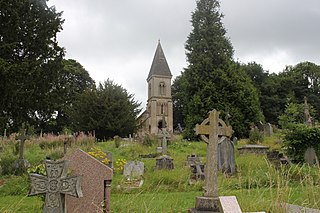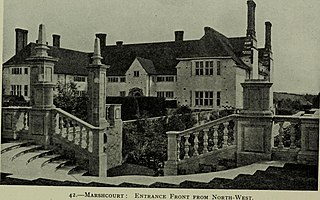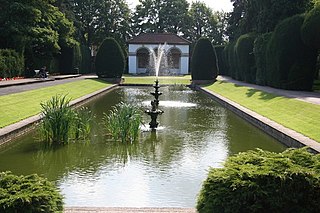

Thomas Francis Tickner (1864-1924) was a British architect.


Thomas Francis Tickner (1864-1924) was a British architect.
Thomas Francis Tickner was born in 1864. [1]
Tickner was an architect. He designed The Biggin Hall Hotel, a Grade II listed public house at 214 Binley Road, Coventry, CV3 1HG. It was built in 1921-23 for Marston, Thompson & Evershed, and was Grade II listed in 2015 by Historic England. [2]
He also designed the 90 feet (27 m) high Coventry War Memorial, the most prominent construction in War Memorial Park. It was finished in 1927. [3]
Tickner died in 1924. [1]

The Hall of Memory in Centenary Square, Birmingham, England, designed by S. N. Cooke and W. N. Twist, is a war memorial erected 1922–25, by John Barnsley and Son, to commemorate the 12,320 Birmingham citizens who died in World War I.

Albert Square is a public square in the centre of Manchester, England. It is dominated by its largest building, the Grade I listed Manchester Town Hall, a Victorian Gothic building by Alfred Waterhouse. Other smaller buildings from the same period surround it, many of which are listed.

New Hall Manor is a medieval manor house, now used as a hotel, in Sutton Coldfield, West Midlands, England.

Albion House is a Grade II* listed building located in Liverpool, England. It was constructed between 1896 and 1898 and is positioned on the corner of James Street and The Strand across from the Pier Head.

Mells is a village and civil parish in Somerset, England, near the town of Frome.
Paul Waterhouse,, was a British architect.

The War Memorial Park is a large park of about 48.5 hectares in southern Coventry, England. The park was opened in July 1921 as a tribute to the 2,587 Coventrians who died between 1914 and 1918 fighting in the First World War. The landscaped gardens and sports areas were created in the late-1920s and 1930s, and the most prominent structure in the park is the city's war memorial monument, built in 1927.
Thomas Cecil Howitt, OBE was a British provincial architect of the 20th Century. Howitt is chiefly remembered for designing prominent public buildings, such as the Council House and Processional Way in Nottingham, Baskerville House in Birmingham, Newport Civic Centre, and several Odeon cinemas. Howitt’s chief architectural legacies are in his home city of Nottingham. He was Housing Architect for the City Council, designing municipal housing estates which are often considered to be among the finest in terms of planning in the country.

John Foulston was an English architect who was a pupil of Thomas Hardwick and set up a practice in London in 1796. In 1810 he won a competition to design the Royal Hotel and Theatre group of buildings in Plymouth, Devon, and after relocating he remained Plymouth's leading architect for twenty-five years.

The Anglican Bath Abbey Cemetery, officially dedicated as the Cemetery of St Peter and St Paul, was laid out by noted cemetery designer and landscape architect John Claudius Loudon (1783–1843) in 1843 on a picturesque hillside site overlooking Bath, Somerset, England. The cemetery was laid out between 1843 and 1844.

Rochdale Cenotaph is a First World War memorial on the Esplanade in Rochdale, Greater Manchester, in the north west of England. Designed by Sir Edwin Lutyens, it is one of seven memorials in England based on his Cenotaph on Whitehall in London and one of his more ambitious designs. The memorial was unveiled in 1922 and consists of a raised platform bearing Lutyens' characteristic Stone of Remembrance next to a 10-metre (33 ft) pylon topped by an effigy of a recumbent soldier. A set of painted stone flags surrounds the pylon.

Thomas Henry Nowell Parr FRIBA was a British architect, best known for designing pubs in west London. Many of these were built while Parr was "house architect" for Fuller's Brewery. Parr designed various buildings in Brentford while he was surveyor and then architect to the Council from 1894 to 1907.

The Civil Service Rifles War Memorial is a First World War memorial located on the riverside terrace at Somerset House in central London, England. Designed by Sir Edwin Lutyens and unveiled in 1924, the memorial commemorates the 1,240 members of the Prince of Wales' Own Civil Service Rifles regiment who were killed in the First World War. They were Territorial Force reservists, drawn largely from the British Civil Service, which at that time had many staff based at Somerset House.
Arthur Edward Sewell (1872–1946) was an English architect, particularly known for the public houses he designed whilst working as the in-house architect for Truman's Brewery. His career peaked in the 1920s and 1930s, and at least five pubs that he designed in that period are now listed buildings with Historic England. In all, he designed around 50 pubs.

The Biggin Hall Hotel is a Grade II listed public house at 214 Binley Road, Coventry, CV3 1HG.

Marshcourt, also spelled Marsh Court, is an Arts and Crafts style country house in Marsh Court, near Stockbridge, Hampshire, England. It is constructed from quarried chalk. Designed and built by architect Edwin Lutyens between 1901 and 1905, it is a Grade I listed building. The gardens, designed by Lutyens and Gertrude Jekyll, are Grade II* listed in the National Register of Historic Parks and Gardens.

The Gerrards Cross Memorial Building is a community centre and First World War memorial in the village of Gerrards Cross in Buckinghamshire, to north west of London, England. The building was designed by British architect Sir Edwin Lutyens, known for designing the Cenotaph in London and numerous other war memorials; it is the only instance of Lutyens designing a war memorial with a functional purpose, rather than as a monument in its own right.

Spalding War Memorial is a First World War memorial in the gardens of Ayscoughfee Hall in Spalding, Lincolnshire, in eastern England. It was designed by the architect Sir Edwin Lutyens. The proposal for a memorial to Spalding's war dead originated in January 1918 with Barbara McLaren, whose husband and the town's Member of Parliament, Francis McLaren, was killed in a flying accident during the war. She engaged Lutyens via a family connection and the architect produced a plan for a grand memorial cloister surrounding a circular pond, in the middle of which would be a cross. The memorial was to be built in the formal gardens of Ayscoughfee Hall, which was owned by the local district council. When McLaren approached the council with her proposal, it generated considerable debate within the community and several alternative schemes were suggested. After a public meeting and a vote in 1919, a reduced-scale version of McLaren's proposal emerged as the preferred option, in conjunction with a clock on the town's corn exchange building.

Mells War Memorial is a First World War memorial by Sir Edwin Lutyens in the village of Mells in the Mendip Hills of Somerset, south-western England. Unveiled in 1921, the memorial is one of multiple buildings and structures Lutyens designed in Mells. His friendship with two prominent families in the area, the Horners and the Asquiths, led to a series of commissions; among his other works in the village are memorials to two sons—one from each family—killed in the war. Lutyens toured the village with local dignitaries in search of a suitable site for the war memorial, after which he was prompted to remark "all their young men were killed".

Coventry War Memorial stands at the centre of War Memorial Park, to the south of the city of Coventry in England. The memorial is a tapering tower 87 feet (27 m) high, completed in 1927. It was restored in 2011, and designated as a Grade II* listed building in January 2013. At the same time, the park was itself listed at Grade II, and the gates and gate posts at the park's main entrance were separately Grade II listed.